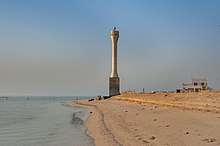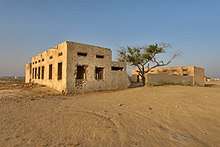Al Ghariyah
| Al Ghariyah الغارية | |
|---|---|
| Village | |
 | |
 Al Ghariyah Location in Qatar | |
| Coordinates: 26°4′41″N 51°21′42″E / 26.07806°N 51.36167°ECoordinates: 26°4′41″N 51°21′42″E / 26.07806°N 51.36167°E | |
| Country |
|
| Municipality | Ash Shamal |
| Established | 1885 |


Al Ghariyah (Arabic: الغارية) is a village on the northeast coast of Qatar located in the municipality of Ash Shamal. It was founded in 1885 by settlers from the town of Al Wakrah. It was a site of contention between Qatari tribes allied with the Ottomans and sheikh Jassim bin Mohammed Al Thani.[1]
A number of ancient cup-marks and rock engravings were discovered in Al Ghariyah.[2]
Etymology
The name 'Ghariyah' is derived from the Arabic word for cave, 'ghar'. It was so named because the area contains many mountains with small caves.[3]
Geography
Because of Al Ghariyah's precise location on the coast, in the past its inhabitants lacked direct access to the groundwater. Additionally, the water that could be obtained was saline.[4] Therefore, the village formed a trade relationship with the nearby settlements of Al `Adhbah, Filiha, and Ain Sinan in which it would receive water in exchange for sea goods such as fish and pearls.[5]
History
Al Ghariyah was first settled in 1885 by a group of 100 members of the Al-Buainain and Al-Jehran tribes who had left the town of Al-Wakrah after a dispute with sheikh Jassim bin Mohammed Al Thani. Al Ghariyah was almost immediately attacked by Jassim's troops. This, however, did not deter the town's growth.[6] Mohammed bin Abdul Wahab (not to be confused with the Wahabi founder), a brother in-law of Jassim, soon emerged the sheikh of the town. He came to lead the coalition formed to resist Jassim's rule, with the ultimate goal achieving independence for Al Ghariyah.[6]
A meeting was soon summoned between Sheikh Jassim and Mohammed bin Abdul Wahab and the discussion was mediated by an Ottoman commander of an Al Bidda-situated gun boat. The Ottoman commander's proposal that the coalition be left alone infuriated Sheikh Jassim. This incited tribesmen loyal to Sheikh Jassim to attack Al Ghariyah, but they were defeated, with the Bani Hajr tribe suffering a few casualties.[1]
In an attempt to earn favor with the Ottomans stationed in Qatar while simultaneously undermining Jassim's authority, Abdel Wahab suggested the establishment of an Ottoman customs in Doha. Although the inhabitants of Doha protested against it, the Ottomans favored his suggestion.[1] In May 1885, out of a coalition of 50 Ottoman troops who arrived that month, 20 had been sent to protect Al Ghariyah. It was also reported that the Mutasarrıf of Al Hasa proclaimed Al Ghariyah to be Ottoman territory.[7]
Some time after its settlement, Al Ghariyah was mostly abandoned by its original settlers after the town founder, Mohammed bin Abdul Wahab, had a meeting with 250 members of the Al-Jehran tribe who by then had migrated to Al Ghariyah. The meeting, held in Bahrain, concluded that the founding tribes would leave Al Ghariyah and settle an area in Qatif with Mohammed bin Abdul Wahab as their leader.[7]
In 1917, Al Ghariyah was described as a deserted village with the remains of a ruined fort in its confines.[8]
In the 21st century, the Qatari government has been active in implementing projects in Al Ghariyah in an attempt to develop it as a tourist destination. One such project is the Al Ghariyah Resorts, which features many high-end villas overlooking the coast.[9]
Education
The settlement's first formal school was opened in 1957.[10]
References
- 1 2 3 "'Persian Gulf Gazetteer. Part 1. Historical and political materials. Precis of Turkish expansion on the Arab littoral of the Persian Gulf and Hasa [Al-Hasa] and Katif [Al-Qaṭīf] affairs.' [56] (68/160)". Qatar Digital Library. Retrieved 14 July 2015.
- ↑ A. Ghosh (1968). "Report on the protection of cultural heritage and development of a museum" (PDF). UNESCO. p. 6. Retrieved 28 July 2015.
- ↑ "GIS Portal". Ministry of Municipality and Environment. Retrieved 10 August 2017.
- ↑ Phillip G Macumber (2012). "An examination of the impact of environmental disparity on the occupation of Qatar". University of Copenhagen. p. 24. Retrieved 5 July 2018.
- ↑ Phillip G. Macumber (2015). "Water Heritage in Qatar" (PDF). Cultural Heritages of Water: Thematic Study on The Cultural Heritages of Water in the Middle East and Maghreb. UNESCO World Heritage Convention. UNESCO. p. 226. Retrieved 5 July 2018.
- 1 2 Zahlan, Rosemarie Said (1979). The creation of Qatar (print ed.). Barnes & Noble Books. p. 51. ISBN 978-0064979658.
- 1 2 "'Persian Gulf Gazetteer. Part 1. Historical and political materials. Precis of Turkish expansion on the Arab littoral of the Persian Gulf and Hasa [Al-Hasa] and Katif [Al-Qaṭīf] affairs.' [57] (69/160)". Qatar Digital Library. Retrieved 14 July 2015.
- ↑ "'Gazetteer of Arabia Vol. II' [1491] (564/688)". Qatar Digital Library. Retrieved 28 July 2015.
- ↑ "Tourism". Embassy of Bangladesh in Doha, Qatar. Retrieved 21 August 2018.
- ↑ Abdulla Juma Kobaisi (1979). "The Development of Education in Qatar, 1950–1970" (PDF). Durham University. p. 41–42. Retrieved 19 December 2015.